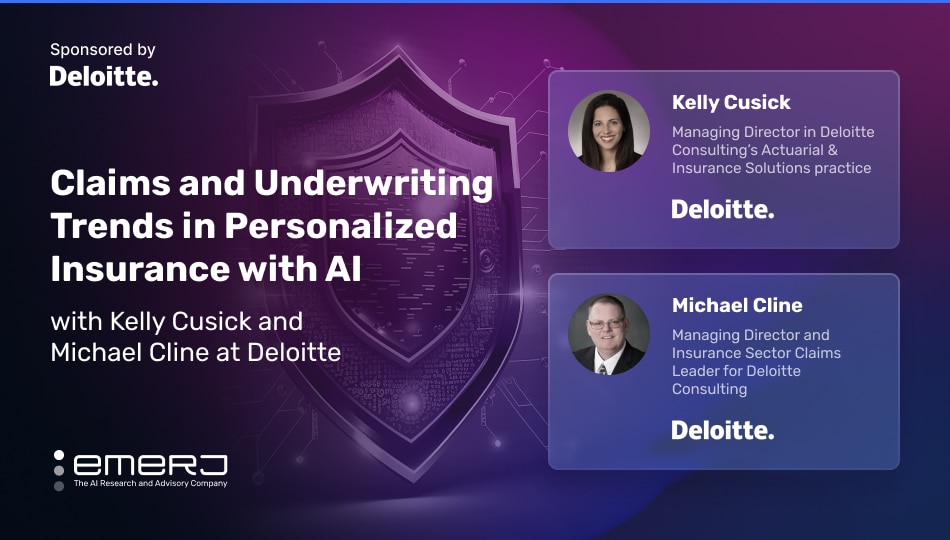This interview analysis is sponsored by Deloitte and was written, edited, and published in alignment with our Emerj sponsored content guidelines. Learn more about our thought leadership and content creation services on our Emerj Media Services page.
Insurers increasingly turn to AI, including generative AI (GenAI), to autoAmate traditionally manual and people-driven claims processes. In the underwriting department, GenAI drives efficiencies across operations, optimizing pricing models, preventing risk, and enhancing personalization capabilities.
The word “transformative” is often used as a hyperbole to describe AI and its capacity as a change agent, but GenAI does indeed appear to be reshaping insurance operations. Per a report by Deloitte, the GenAI for the insurance market is expected to grow from $761 million in 2022 to $14.4 billion in 2032 – a CAGR of 32%.
To get an insider perspective on the transformative effect of GenAI, we spoke with Deloitte’s Kelly Cusick and Michael Cline. Kelly and Michael have over two decades of insurance consulting experience and currently serve as Managing Directors at Deloitte Consulting LLP.
Both guests acknowledge GenAI’s extraordinary potential while discussing its integration’s technical and non-technical challenges. We examine the trend further in the section below titled “Evaluating Data and Process Challenges.”
From our interview with these two insurance veterans, we highlight four key takeaways:
- Embracing personalization and risk prevention: Integrating AI tools capable of delivering personalized outputs, insurers can create tailored solutions that consider each policyholder’s unique risk profile.
- Evaluating data and process challenges: Overcoming data management issues such as data silos and unstructured information is a prerequisite for fully leveraging advanced AI technology, including GenAI.
- Expanding reach to underinsured markets: Leveraging GenAI’s ability to process vast data stores and produce more precise recommended actions, insurers can tailor products capable of catering to underserved and underinsured customers.
- Understanding – and leveraging – strengths and differences of GenAI and humans: Having in mind the proper place for GenAI as “another tool in the toolkit” while leveraging both the versatility of GenAI and the human capacity to validate, act on, and provide a “human touch” to the customer will empower insurers and their policyholders.
Listen to the full episode below:
Guest: Kelly Cusick, Managing Director in Deloitte Consulting’s Actuariall & Insurance Solutions practice.
Expertise: Property and Casualty insurance, product management, product innovation, underwriting, actuarial consulting
Brief Recognition: Ms. Cusick, a University of Notre Dame mathematics graduate, has spent her entire career at Deloitte. Initially a Senior Manager for a decade, she performed actuarial and financial analysis for insurers. Later, she advanced to Managing Director at Deloitte’s Actuaries & Consultants Limited, leading the underwriting division’s consultancy for insurance firms.
Guest: Michael Cline, Managing Director and Insurance Sector Claims Leader for Deloitte Consulting.
Expertise: Property and Casualty insurance, liability, change management, project management
Brief Recognition: Michael Cline, with almost 30 years in insurance and executive positions at firms like Ernst and Young, holds five professional designations, including the esteemed CPCU certification. He recently authored a Deloitte-published report on the transformative effects of GenAI titled “Generative AI and the Future of Work.”
Embracing Personalization and Risk Prevention
Ms. Cusick begins by discussing the emerging trend within the insurance sector to aid individuals and business customers in proactive risk prevention. Moreover, she states that a rising demand for personalized insurance products and services like Amazon is now well-established.
Cusick hits on two main points regarding personalized product development. The first is advancement in tailored offerings, such as pay-as-you-go models. She states that small business owners, in particular, benefit from these tailored product offerings by allowing them to manage cash flow better. She emphasizes the importance of delivering an Amazon-like experience in every customer interaction.
This shift towards personalization serves a dual purpose for insurers:
1. Meets the heavy demand for tailored products and services, ensuring that customers feel that their unique needs are understood and catered to.
2. Aids in determining the level of risk and appropriate pricing for each customer.
GenAI’s advanced processing capabilities, which encompass natural language processing (NLP) and pattern recognition using algorithms, enable a high level of personalization by producing outputs with exceptional granularity.
Such in-depth analysis enables insurers to craft detailed customer profiles capable of uncovering previous hidden correlations and trends. As a result, brokers are equipped to present current and prospective customers with policy offers highly tailored to meet their individual needs.
These advanced processing capabilities enable another powerful and potentially profitable use case: marketing to and attracting underserved insurance markets.
Evaluating Data and Process Challenges
Both Kelly and Michael note that, despite the progress of integrating advanced AI into operations, insurers must contend with significant data and process barriers before fully realizing GenAI capabilities. These include:
- Capital-intensive manual processes in underwriting: Resources and capital invested in retraining workers and upgrading technological infrastructure should be correctly allocated to low-value, high-resource tasks.
- Voluminous unstructured data: PDF files, website data, etc. – spread out across silos, making it difficult to both locate said data and integrate it into an advanced AI platform.
- Legacy system presence: Though less ubiquitous than in recent years, legacy systems remain a commonly cited reason for delaying or ruling out the implementation of more modern AI platforms.
Ms. Cusick emphasizes the importance of acknowledging these barriers and discusses how these obstacles are related to worker resistance:
“I think that some of the challenges that have previously hindered advancements in using AI and generative AI are that there’s still a lot of manual processing and underwriting, and that consumes the human capital of organizations and the energy that you might have from those that would help to develop solutions or think about doing things differently. Because if you think about underwriters, they really love analyzing risk and doing deals; they don’t like processing emails and scraping websites to figure out what they need. So I think that that’s been a big challenge in the past.”
– Kelly Cusick, Managing Director in Deloitte Consulting’s Actuarial & Insurance Solutions practice
Expanding Reach to Underinsured Markets
Ms. Cusick goes on to explain how GenAI is assisting in insurers’ efforts to uncover data across diverse data sources to build insurance products capable of attracting uninsured and underinsured individuals and business owners — and how these efforts are directly related to producing actionable insights:
“(GenAI’s) ability to take information from underwriters and risk control professionals and claims professionals – and stitch it all together – so that one can turn that into actionable insights and either put it into an underwriter’s hands as they’re on the front lines making decisions for their customers or (so) that they have more precise information and a better understanding of where their book is, they can maybe make a different decision and help some of those uninsured folks that are out there.”
– Kelly Cusick, Managing Director in Deloitte Consulting’s Actuarial & Insurance Solutions practice
We may infer that AI and GenAI help insurers feasibly and profitably accomplish this by:
- Lowering operational costs: As mentioned, AI is ubiquitously used within insurance companies to automate manual-intensive processes such as claims, customer service, and underwriting.
- Enabling more accurate risk assessments: By analyzing alternative data sources, GenAI models allow insurers to identify risks for a segment that previously lacked extensive claims history more accurately and quickly. Insurers are then able to price policies accordingly.
- Producing more nuanced customer segments: The capacity of advanced AI – including GenAI – to analyze and subset vast datasets enables the identification of micro-segments within uninsured and underinsured populations. As a result, insurers are in a stronger position to approach individuals within these segments with a potentially attractive policy.
Understanding – and Leveraging – the Strengths and Differences of GenAI and Humans
Both guests state the importance of:
- (A) Acknowledging the well-established potential of advanced AI technology and taking action to integrate said technology into operations (which includes rectifying the obstacles to integration mentioned above) and
- (B) recognizing the critical place of human insurance professionals.
Michael emphasizes the importance of seeing GenAI as “just another tool in the toolkit for the claims profession” and that claims professionals are needed to validate and handle the following best actions.
He also discusses the criticality of maintaining the human touch during challenging times, regardless of the complexity of the claim or the ability of advanced technology to expedite:
“You could have high frequency, low complexity claims or you could have very complex claims, and you cannot leave the insured or the claimant by the wayside just because technology can drive the process. There’s a lot of emotion that is involved in claims … A property loss, you get into a serious car accident, someone’s injured … They’re looking to have their hands being held there; the compassion, the understanding, and if you drive technology into the process, 100% they feel left behind in that. So there’s a balance between technologies, between using generative AI and next best actions and driving those decisions, and leaving the customer.”
– Michael Cline, Managing Director and Insurance Sector Claims Leader, Deloitte
At the same time, he recognizes and encourages insurers to leverage GenAI’s potential if appropriate. He echoes Ms. Cusick’s insights on GenAI’s ability to reshape claims processes in ways that mimic those of the underwriting side.
Michael states that GenAI is transforming several areas of claims operations operations:
- Processing and analyzing large volumes of unstructured data
- Automating collection and organization of data
- Automating and streamlining previously manual processes
- Expediting and augmenting decision-making
- Claims segmentation and routing


















